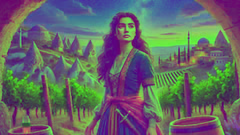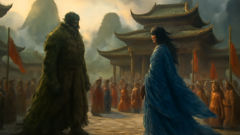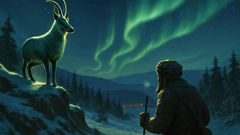Introduction
Across the vast sweep of steppe and Anatolian plain there moves a figure who seems to belong to wind and memory more than to any single village. He is called Korkut Ata—Dede Korkut, the grandfather of stories—part sage, part minstrel, and wholly a keeper of the moral map for a people who read their lives by horses' breath and the star patterns of migration. In this retelling, the crumbled tents of winter and the bright marketplaces of summer are not merely backdrops but living pages where Korkut's words find purchase in the hands of warriors and the laps of children. He arrives with a satchel of parchment, a reed instrument whose notes can soften a grieving household, and a staff carved with cryptic runes that map the routes his ancestors took between river and ridge. The townsfolk know him by the gentle lines around his eyes and the cadence of his voice—low as the earth, buoyant as a spring—in which he tells sagas that hold both warning and permission: warning against pride that makes a man hunt his own brother, permission to leap into necessary risk when honor or mercy demand it. His tales are not static; they are stitched into the rhythm of everyday choices—how to repair a torn herd, how to choose a bride whose laugh becomes the hearth, how to stand when allies waver. This story does not aim to be an exact transcription of the ancient manuscripts; rather, it is an imaginative tribute to the spirit of Dede Korkut's living tradition. Here, you will meet travelers and householders, proud warriors and weary women, each of whom carries a piece of the sage's counsel into the night. Along the way, we will listen for the motifs that make these tales vital: a test of courage that demands cleverness as much as force; a moment of reconciliation that reshapes a clan; an honest lament that turns to hope. The legend is a map and a mirror—the map of a people who moved across continents, and the mirror in which they saw what they must become to survive: generous, cunning, steadfast, and humane. Korkut's voice shapes the tale, but the true character lies in the communities he visits. Their rituals, their laments, and their songs are what keep the saga breathing. You will find here a tapestry of episodes—some whispered by the firelight, some proclaimed in the public square—each designed to explore how wisdom travels and how an oral tradition becomes the skeleton of cultural memory. Read on as wind and story braid together, carrying the Legend of Korkut Ata beyond the pages and into the living world of those who still gather to listen.
Roots of the Sage: When Stories Became Maps
The first time the people called him 'Ata'—father, elder—there was a storm that came with a smell of distant rain and the sound of a thousand hooves. Korkut had arrived out of an evening shadow, not as a conqueror but as a visitor who knew how to ask the right questions. He spoke little about his origin; sometimes he would say he had been traveling since before the last snow, sometimes that the steppe itself had shaped him. In his talks he used names of rivers and mountain passes that older men recognized but younger men had never seen. He told parables instead of giving direct orders, and the craftsmen, warriors, and mothers who heard him found their days rearranged by a line of his speech.
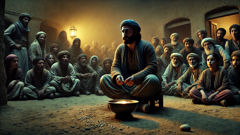
He had a curious habit: when a village's council argued, Korkut would ask for a cup of water and a small stone. Holding the stone, he would let it sit in the water for a while, watching its shadow. When asked why, he answered simply, As water reveals the stone's shadow so the story reveals a man's truth. That image became a test—anyone who wished to be judged by a clan could present their case in a story, and the listening would be the measure of justice. The stories he told served as maps: the moral terrain more important than mere geography. When a youth named Yalin sought advice about revenge for a slain cousin, the elder did not say fight or do not fight. Instead Korkut told of a fox who followed the scent of anger until it lost its own tracks, leaving only an empty den. From that line, the youth extracted the counsel to consider consequences and to weigh the destruction that a single act might seed. It was not pacifism that Korkut preached so much as deliberate courage—an ethic that honored both bravery and calculation.
Korkut's influence spread not through force but through ritualized listening. When a wedding was anticipated, he would be invited to sit in the tent by the bride's side and tell a tale about the first night a family was formed: a story that included how patience, a shared laugh, and small acts of humility kept a household from fraying. When drought came, he sang songs that included metaphors of deep wells and shared grain, reminding people that survival in the steppe required mutual aid. Because he believed words could heal, he often sat with those struck by grief, repeating a tale of a shepherd who planted a tree in memory of a friend; in time, the sapling's shade gathered both sorrow and solace.
There are episodes in Korkut's wanderings that sound like embodiments of parable. In one remembered scene he arrives at a mountain pass blocked by a quarrel between two tribes over grazing rights. The warriors had sharpened their spears and the air tasted like iron. Korkut asked for a single bowl. He filled it with water and then asked each side to recall a childhood memory involving kindness. As they spoke, their hardened faces softened, and the bowl's surface reflected not the sky but themselves. Korkut then set the bowl on the ground and told a story about two brothers who found, in their old age, that half of their herd could not feed both households; they separated with bitter words and later realized that their shared memory of an old winter's shelter bound them more than the pasture did. The moral was not abstract: it provided a framework for negotiation. In such ways, Korkut turned stories into instruments of practical diplomacy.
Korkut was also a collector of names and songs. When he heard a melody that pleased him, he would trace it in the air with a finger and teach it to the village children. He believed that songs were the memory-ridges of a culture; they kept old bargains, old griefs, and old promises alive in a manner that laws seldom could. His verses contained repeated lines—hooks that someone could take up later at a market or in a caravan. This mnemonic craft is why the legend of Korkut rewards repetition: it allows the tale to survive in fickle memory. Many a time, when a band of traders crossed high country, they would hum a line Korkut had taught them and find that the tune brought luck in small matters—safe passage at a river crossing, the favor of a caravan guard, or the patience of a mule.
His image in the early years was not of effortless authority but of a man continually proving his counsel true. At a time when a wandering band of refugees fled a burned homestead, Korkut advised building temporary shelters in a ring with a communal hearth at the center. He taught how to rotate watch duties by drawing lots, a simple act that deferred favoritism. Practical techniques paired with parables. People learned to regard his presence as an engine of civic practice: he did not replace a leader but improved the way leaders listened. That combination is central to understanding Korkut's role: he did not claim infallibility; he cultivated frameworks where communities could judge and remake themselves without tearing their social fabric.
Yet there was mystery about him that could not be straightforwardly explained. Some nights, after councils dispersed and lanterns guttered low, villagers swore they heard from his tent a music unlike any other—notes that seemed to coax the hillside into memory. Children whispered that Korkut spoke with ancestors; elders nodded as if to confirm it, though none would claim to know details. The aura of mysticism that drifted around him made his counsel easy to accept and hard to challenge. Even skeptics admitted that his presence shifted the tenor of events: disputes softened, alliances formed more durably, and the hum of ordinary life resumed with a different cadence. The sage had become a living archive: the repository of a people's conscience and the mapmaker of its behavior.
Stories, in Korkut's hands, were never decorative. They were tools, history, law, and prayer. They preserved a people's sense of self by turning moral choice into tale, and choice into habit. Over time, as caravans traced old routes across Anatolia and the steppe, they carried not only rugs and salt but the echo of his stories. Merchants hummed his refrains; blacksmiths hammered rhythm into metal echoing his verses; mothers sang his lines to lull their infants. The living archive grew. In that way the legend of Korkut Ata became less about a single man and more about a cultural architecture: a way to speak of what mattered and how one might live so that one's children could inherit a world fit for human dignity.
Tales of Counsel: Trials, Reconciliation, and the Living Song
Korkut's tales often began with a crackle of domestic detail: a child losing a lamb, a seamstress repairing a torn banner, a warrior sharpening an old blade. He used humble moments as openings to discuss great questions. One of his recurring themes was the nature of trials—how a test reveals more than skill. A test reveals character: the willingness to temper pride, the capacity to forgive, and the stubbornness to keep going when all seems lost. Take the tale of a young horseman named Miran, newly married and impatient with his father-in-law's cautious ways. Miran's pride led him to challenge a neighboring chieftain in a contest of horsemanship. Defeat would have been humiliation; victory might have been a life of arrogant claims. Korkut told this story not to glorify victory but to show how Miran's understanding of honor matured when he returned from the contest with his horse lamed and his ego wounded. Faced with the choice of blaming others or mending the harm, Miran chose restoration: he asked forgiveness from his father-in-law, learned to treat the injured horse with care, and in doing so found a steadier kind of respect that lasted longer than a single triumph. The moral found its way into everyday life: young men rowing up in Korkut's orbit discovered how to turn defeat into apprenticeship.
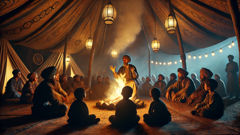
Reconciliation is another thread that runs through his tales. Korkut believed that many feuds begin as misreadings. A quarrel that lasts decades often started as a misinterpreted gift or an insult taken in the heat of a feast. To undo a feud, he recommended a ritual of exchange: share a loaf baked from the same grain, walk together to a boundary, plant a sapling with names carved on its bark. Such gestures are not magical; they are practical resets. In one retelling, two shepherd clans had fought over a narrow valley for generations. Korkut suggested they hold a joint night-watch, alternating responsibility and sharing stories at dawn. Over months, they learned to respect each other's rhythms and to notice small acts of kindness—mending a boot, sharing salt, tending a sick foal. The sapling they planted became a known marker; its shade was a place where children from both clans played together, erasing the neatness of earlier prejudice.
Korkut's stories often included an element of cunning. Courage alone would not always solve a problem; cleverness was necessary in equal measure. There is a remembered episode of a fortified wealthy caravan that refused passage to a poor family fleeing winter. The chieftain declared strict rules: no exceptions. The poor family was stopped at the gate with a child shivering and a sack of meager belongings. Korkut intervened not with words at first but with a tale about a hungry wolf who learned to stand on its hind legs to look taller, tricking a careless guard into thinking it was a different beast entirely. The caravan leaders laughed at the tale, until Korkut, with a gentle twist, recited the names of those who had once sought refuge within the same gates in earlier times. The memory unsettled them. In the end, the caravan conceded passage for the poor family in exchange for a promise to work in the caravan's fields that spring. The narrative nudged compassion into a practical compromise—an elegant kind of policy born of story. Korkut taught that even rulers could be persuaded by tales that honored their self-image while asking them to widen their charity.
The living song served as a moral ledger. Once, during a long winter, Korkut taught a lament about a woman who baked bread and hid it beneath straw to feed neighbors. That lament became a song that repeated the names of those she fed and the days they shared. When famine eased, villagers could still sing the names and remember debts of kindness that could not easily be paid in coin. Stories embedded reciprocity in cultural memory. That is how a society with few written ledgers kept track of favors, offenses, vows, and debts: through repetition, ritual, and song.
There were also explicit parables on leadership. When a newly chosen chieftain celebrated his victory, Korkut did not offer unalloyed praise. Instead he told of a captain who inherited a fleet with leaky hulls: if he sailed without repairing them the fleet would fracture; if he slowed to mend, his men might grumble. The choice between speed and maintenance is a leadership lesson—longer-lasting power comes from repairing what binds a group together. Several leaders took the story to heart: they conducted inventories, redistributed resources, and scheduled repairs. Their rule, governed by the rhythm of maintenance, lasted longer than that of rash rulers who celebrated immediate glory but ignored the quieter work of sustaining a people.
Korkut's counsel also extended to matters of identity. In a time when tribes intermarried and the boundaries of belonging shifted with each season, he insisted that identity was not a fixed label but an ongoing practice. One of his tales involves a mother who taught her daughter two songs: one in the tongue of their current village, another from the land of her birth. The daughter learned both and when she married into another clan, she could sing either song as needed, thereby splicing her loyalties together without losing herself. Korkut used such images to undermine the logic of absolute exclusion; he offered instead a porous sense of self, one that honored roots while allowing new branches to grow.
Throughout these episodes, Korkut's voice remained deceptively light. He favored vivid images—winds that carry scent, horses that fold into shadow, cups passed across nights of treaty-making. His stories were not just moral lessons but sensory events: the scent of mutton cooking, the scrape of leather, the sting of cold on a cheek. By making ethics tactile, he made them memorable. Those who heard a tale and felt it in their bones were more likely to remember it at a crucial moment: on the battlefield, in the marketplace, or in the hush of a child's bedside. That is the enduring appeal of the Korkut tradition: it converts intangible virtues into things you can carry on a long journey.
Conclusion
Korkut Ata is not a single voice frozen in parchment but an echo threaded through generations—an ethic that insists stories must do more than entertain. They must teach how to bind a people together when storms come, how to recognize the cost of pride, how to enact mercy that neither breeds weakness nor permits injustice. The ledger of a society, under his influence, became a weave of songs, shared rituals, and remembered favors. Across Anatolia and the steppe, caravans and village hearths carried these memories like seeds: planted in new soil they took root as customs and laws, as wedding songs and work rituals. Even as nations formed and texts were finally written, the oral frame that Korkut cultivated stubbornly remained. In modern towns visitors still hear older women hum refrains first sung around herding fires; in urban cafés students quote the line of a Korkut-like parable; in classrooms teachers use his model of narrative judgment to teach conflict resolution. The Legend of Korkut Ata endures because it is practical wisdom dressed as story. It teaches a surprising humility that does not diminish courage, and a courageous humility that does not surrender principle. It invites people to carry memory carefully and to teach it generously. If there is an inheritance to be had from such a figure, it is the lesson that a culture's survival depends on its skill in speaking to itself well: telling stories that name misdeeds, that repair breaches, that amplify compassion without excusing malice. So long as people gather at dusk to pass a cup, to listen for shadows in water, and to teach children the old refrains, the spirit of Korkut will linger—less a relic and more a living practice. His legend, then, is an instruction manual for the heart, a map for communal life, and a reminder that wisdom travels when words are shared with care and repetition.


